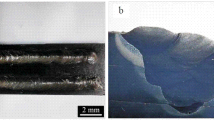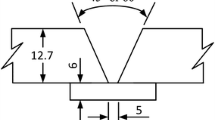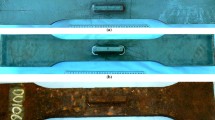Abstract—
The possibility of evaluating residual welding stresses using magnetoanisotropic and X-ray diffractometry is considered. Using the method of magnetic anisotropy, the degree of inhomogeneity of residual stresses in hard-facing specimens made with flux-cored wire and coated electrode in air and underwater has been revealed. The use of two methods of nondestructive testing has made it possible to determine and compare the values of residual welding stresses.













Similar content being viewed by others
REFERENCES
Totten, G., Handbook of Residual Stress and Deformation of Steel, Ohio: ASM Int., 2002.
Breidenstein, B., Heikebrügge, S., Schaumann, P., and Dänekas, C., Influence of the measurement parameters on depth-resolved residual stress measurements of deep rolled construction steel using energy dispersive X-ray diffraction, HTM J. Heat Treat. Mater., 2020, vol. 75, pp. 419–432.
Farajian, M., Nitschke-Pagel, T., and Dilger, K., Stability and relaxation of welding residual stresses, Mater. Sci. Forum, 2011, vol. 681, pp. 55–60.
Gurova, T., Estefen, S.F., and Leontiev, A., Time-dependent redistribution behavior of residual stress after repair welding, Weld. World, 2017, vol. 61, pp. 507–515.
Radaj, D., Welding residual stress and distortion. Calculation and measurement., Düsseldorf: DVS-Verlag, 2003.
Gkatzogiannis, S., Knoedel, P., and Ummenhofer, T., Simulation of welding residual stress—From theory to practice, Math. Modell. Weld Phenom., 2019, vol. 12, pp. 383–400.
Goldak, J.A. and Akhlaghi, M., Computational Welding Mechanics, New York: Springer, 2005.
Kopelman, L.A., Osnovi teorii prochnosti svarnykh soedinenii. Uchebnoe posobie (Fundamentals of the Theory of Strength of Welded Structures. A Textbook), St. Petersburg: Lan’, 2010.
Parshin, S.G., Metallurgiya podvodnoi i giperbaricheskoi svarki (Metallurgy of Underwater and Hyperbaric Welding), St. Petersburg: Izd. Poliitekh. Univ., 2016.
Bo Zhao, Ji Chen, Chuanbao Jia, and Chuansong Wu, Numerical analysis of molten pool behavior during underwater wet FCAW process, J. Manuf. Proc., 2018, vol. 32, pp. 538–552.
Maksimov, S.Yu. and Lyakhovaya, I.V., Wet underwater welding of high-strength low-alloy steels, Avtom. Svarka, 2013, no. 8, pp. 43–46.
Gao Wen-Bin, Wang Dong-Po, Cheng Fang-Jie, Deng Cai-Yan, and Xu Wei, Underwater wet welding for HSLA steels: Chemical composition, defects, microstructures, and mechanical properties, Acta Metall. Sin. (Engl. Lett.), 2015, vol. 28, pp. 1097–1108.
Łabanowski, J., Fydrych, D., and Rogalski, G., Underwater welding–A review, Adv. Mater. Sci. Eng., 2008, vol. 8, pp. 11–22.
Dariusz, F. and Grzegorz, R., Effect of shielded-electrode wet welding conditions on diffusion hydrogen content in deposited metal, Weld. Int., 2011, vol. 25, pp. 166–171.
Parshin, S. and Levchenko, A., Technology and equipment for underwater wet welding and cutting of high strength steel arctic structures using flux-cored wires, IOP Conf. Ser.: Earth Environ. Sci., 2020, no. 539, pp. 1–10.
Karkhin, V.A., Teplovye Protsessy pri Svarke (Thermal processes during welding), Saint Petersburg: Polytechnic University Publishing, 2015.
Prilipko, E.A., The process of underwater wet flux-cored wire welding with an external electromagnetic effect, Cand. Sci. (Eng.) Dissertation, Kiev: Kiev. Politekh. Inst., 2013.
Fatkullin, M.R., Fairushin, A.M., and Rizvanov, R.G., Development of technology for welding repair of steel housings using a combination of ultrasonic vibrations and forced cooling, Mater. Sci. Forum, 2020, vol. 989, pp. 747–752.
Ebrahimi, S.M., Farahani, M., and Akbari, D., The influences of the cyclic force magnitude and frequency on the effectiveness of the vibratory stress relief process on a butt welded connection, Int. J. Adv. Manuf. Technol., 2019, no. 102(4), pp. 2147–2158.
Letunovskiy, A.P., Antonov, A.A., and Steklov, O.I., Removal of technological residual stresses in metal structures by low-frequency vibration processing, Zagotovitel’nye Proizdov. Mashinostr., 2012, no. 8, pp. 12–16.
Evstratikova, Ya.I. and Nikulin, V.E., Control of residual welding stresses using the magnetoanisotropic method after applying ultrasonic shock treatment, Svarka Diagn., 2019, no. 4, pp. 38–41.
Rossini, N.S., Dassisti, M., Benyounis, K.Y., and Olabi, A.G., Methods of measuring residual stresses in components, Mater. Des., 2012, vol. 35, pp. 572–588.
Schajer, G.S., Practical Residual Stress Measurement Methods, Chichester: Wiley, 2013, 1st ed.
Mogil’ner, L.Yu. and Skuridin, N.N., Laboratory research of the magnetic anisotropic method for monitoring the stress-strain state of pipelines, Sci. Technol.: Oil Oil Prod. Pipeline Transp., 2021, no. 11 (2), pp. 145–151.
Gorkunov, E.S., Efimov, A.G., Shubochkin, A.E., and Artemiev, B.V., On the application of the magnetic NDT method to determine the stress-strain state of metal structures, V Mire NK, 2016, no. 3 (19), pp. 43–46.
Nichipuruk, A.P., Stashkov, A.N., Ogneva, M.S., Korolev, A.V., and Osipov, A.A., Induced magnetic anisotropy in low-carbon steel plates subjected to plastic deformation by stretching, Russ. J. Nondestr. Test., 2015, vol. 51, no. 10, pp. 610–615.
Zakharov, V.A., Ul’yanov, A.I., and Gorkunov, E.S., Coercive force of ferromagnetic steels under the biaxial symmetrical tension of a material, Russ. J. Nondestr. Test., 2011, vol. 47, no. 6, pp. 359–368.
Dae-Sung Kim, Ji-Hyeung Yoo, and Hong-Duk Moon, Non-destructive stress measurement of civil structural steel using magnetic anisotropy sensor, Int. J. Civ., Struct., Env. Infrastruct. Eng. Res. Dev., 2016, vol. 6, pp. 13–20.
Uchanin, V., Minakov, S., Nardoni, G., Ostash, O., and Fomichov, S., Nondestructive Determination of Stresses in Steel Components by Eddy Current Method, J. Mech. Eng., 2018, vol. 11(64), pp. 690–697.
Chmielewski, M., Piotrowski, L., and Augustyniak, B., A fast procedure of stress state evaluation in magnetically anisotropic steels with the help of a probe with adjustable magnetizing field direction, Meas. Sci. Technol., 2017, vol. 28, pp. 1–11.
Xin Wei, Liang Lin, Ding Keqin, Zhao Yu, and Wang Hongzhu, Study on the magnetic measurement theory and method of residual stress for ferromagnetic components based on magnetic anisotropy, Chin. J. Sci. Instrum., 2020, no. 11, pp. 137–146.
Ksenofontov, N.M., Ensuring the safety and operational reliability of water transport hydraulic structures by preventing degradation failures of elements of their mechanical equipment, Cand. Sci. (Eng.) Dissertation, St. Petersburg: Admiral Makarov State University of Maritime and Inland Shipping, 2019.
Ponomarev, K.E., Strelnikov, I.V., Antonov, A.A., and Bondarenko, A.A., Application of the method of laser interferometry for the selection of vibration processing modes according to the criterion of the level of residual stresses, Zavod. Lab., Diagn. Mater., 2020, no. 86 (2), pp. 54–60.
Ostrivnoi, A.F. and Lobashev, A.A., Metrological support of measurements of mechanical stress, V Mire NK, 2017, no. 3, pp. 58–61.
Gutiérrez, P.H., Rodríguez, F.C., Mondragón, J.J.R., Dávila, J.L.A., Mata, M.P.G., and Chavez, C.A.G., Thermo-mechanic and Microstructural Analysis of an Underwater Welding Joint, Soldagem & Inspeção, 2016, vol. 21, pp. 56–164.
Yong Zhang, Chuanbao Jia, Bo Zhao, Jiakun Hu, and Chuansong Wu, Heat input and metal transfer influences on the weld geometry and microstructure during underwater wet FCAW, J. Mater. Proc. Technol., 2016, vol. 238, pp. 373–382.
ACKNOWLEDGMENTS
The authors are grateful to Cand. Sci. (Eng.) G.N. Vostretsov, I.L. Repin (OOO UNTTs Svarka of the National Testing and Welding Association) for technical support during research, Cand. Sci. (Phys.-Math.) B.N. Barakhtin, N.N. Barakhtina, N.F. Drozdova (NRC Kurchatov Institute, TsNII KM “Prometey”) for consultations and technical support during research.
Author information
Authors and Affiliations
Corresponding authors
Rights and permissions
About this article
Cite this article
Nikulin, V.E., Parshin, S.G. & Levchenko, A.M. Study of Residual Welding Stresses for Underwater Wet Welding of Low-Alloy Steel Using Magnetic Anisotropic and X-ray Diffractometry Methods. Russ J Nondestruct Test 57, 692–705 (2021). https://doi.org/10.1134/S1061830921080076
Received:
Revised:
Accepted:
Published:
Issue Date:
DOI: https://doi.org/10.1134/S1061830921080076




